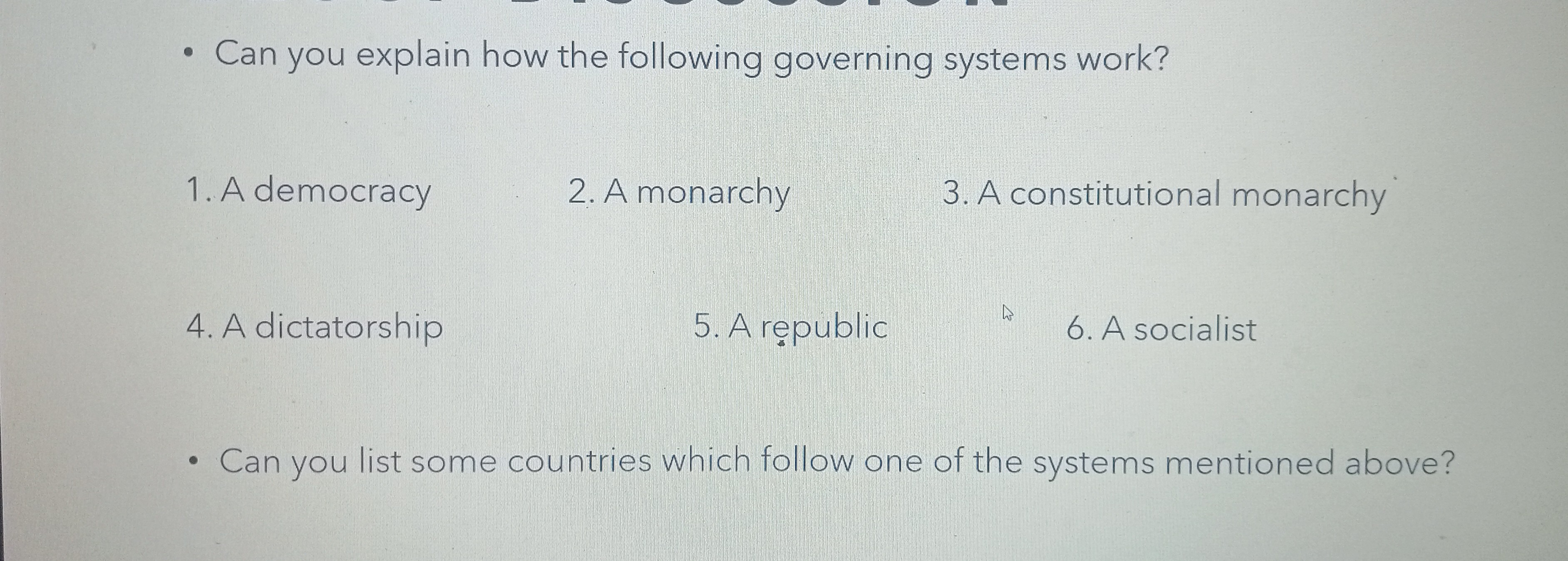

16/04/2024


Làm sao để có câu trả lời hay nhất?
- Luôn có GIẢI THÍCH các bước giải
- Không copy câu trả lời của Timi
- Không sao chép trên mạng
- Không spam câu trả lời để nhận điểm
- Spam sẽ bị khóa tài khoản



16/04/2024


16/04/2024
1. Democracy: Democracy is a form of government in which the power is vested in the people, either directly or through elected representatives. In a direct democracy, citizens participate directly in decision-making processes, such as through voting on laws and policies. In a representative democracy, citizens elect representatives to make decisions on their behalf.
Key features of democracy include:
- Free and fair elections: Citizens have the right to vote for their leaders and representatives in regular, transparent elections.
- Rule of law: The government operates within a framework of laws that apply equally to all citizens.
- Protection of rights: Democracies typically guarantee individual rights and freedoms, such as freedom of speech, assembly, and religion.
- Separation of powers: The government is divided into branches (e.g., legislative, executive, judicial) to prevent any one branch from becoming too powerful.
- Accountability and transparency: Elected officials are accountable to the people, and government actions are transparent to ensure accountability.
Examples of democratic countries include the United States, Canada, the United Kingdom, India, and many others.
2. Monarchy: Monarchy is a form of government in which a single individual, known as the monarch, holds supreme authority and power. The monarch typically inherits the position based on hereditary succession, meaning it passes from one generation to the next within a royal family. Monarchies can be absolute or constitutional.
Key features of monarchy include:
- Hereditary rule: The position of monarch is usually passed down through a royal family lineage, with succession determined by bloodline or other traditional rules.
- Centralized authority: The monarch holds significant political power, which can vary depending on the type of monarchy (absolute or constitutional).
- Symbolic role: In constitutional monarchies, the monarch's powers are often limited by a constitution or laws, and they serve primarily as a symbolic or ceremonial figurehead.
- Influence on government: Monarchs may still have some influence on government decisions, especially in absolute monarchies where they have more authority.
Examples of monarchies include the United Kingdom, Saudi Arabia, Japan, Thailand, and others. Some monarchies, like the UK, are constitutional monarchies where the monarch's powers are limited by law and democratic institutions. Others, like Saudi Arabia, are absolute monarchies where the monarch has more direct authority over governance.
Đăng nhập hoặc Tạo tài khoản miễn phí!

 Điện thoại: 1900636019
Điện thoại: 1900636019
 Email: info@fqa.vn
Email: info@fqa.vn
LIÊN KẾT
- Hỏi đáp bài tập
- Giải bài tập SGK
- Cẩm nang
- Đề ôn luyện
- Điều khoản & chính sách
- Sitemap
- Liên hệ
- Đánh giá và góp ý
FQA.vn Nền tảng kết nối cộng đồng hỗ trợ giải bài tập học sinh trong khối K12. Sản phẩm được phát triển bởi CÔNG TY TNHH CÔNG NGHỆ GIA ĐÌNH (FTECH CO., LTD)
Copyright © 2025 fqa.vn All Rights Reserved












